50th Field Hospital Unit History

Photograph showing Major Jennings B. Marshall (O-400409) in front of the 50th Field Hospital’s official sign at Camp Atterbury, Indiana. Photograph taken in 1943.
Activation & Training:
The 50th Field Hospital was officially activated at Camp Atterbury, Columbus, Indiana (Division Training Camp; acreage 40,513; troop capacity 2,243 Officers and 41,916 Enlisted Men –ed) on 10 September 1943, with Lieutenant Colonel Leon D. Blumberg being assigned Commanding Officer. Recruitment was commenced and training programs implemented. After MTP 8-1 (Mobilization Training Program –ed) had been completed, many of the unit’s Technicians were sent to the Station Hospital for further practical training. At the beginning of 1944, most of the staff was still in training at the station. The organization was up to T/O strength in Enlisted Men, but understrength in Officers. At this time, the total Officers were only three (3) Medical Corps Officers and five (5) Medical Administrative Corps Officers.
Many excellent reports were received from various inspectors as to the condition of the unit during its training period. Additional Technicians were brought in from various Medical Department Enlisted Technicians Schools and assigned to the unit, thus complimenting those required under the unit’s Table of Organization (T/O 8-510 –ed).
On 6 January 1944, 4 Enlisted Men returned to the 50th from Detached Service, Enlisted Technicians School, Billings General Hospital, Fort Benjamin, Indiana. Throughout January, a number of new Officers arrived to complete the understrength Table of Organization. On 9 January 1944, a complement of Army Nurse Corps personnel was assigned to the unit. Nurses assigned for duty were as follows:
2d Lt Helen E. Bevan (N-729905)
2d Lt Mildred D. Carr (N-729518)
2d Lt Helen M. Dishon (N-729276)
2d Lt Margaret M. Edwards (N-732989)
2d Lt Mary J. Fishley (N-729523)
2d Lt Ednah N. Kuttig (N-729190)
2d Lt Mildred D. Lang (N-729246)
2d Lt Mary E. Linkel (N-728922)
2d Lt Cleona O. Lockhart (N-729248)
2d Lt Mary O. Lynn (N-729249)
2d Lt Mary E. Mayer (N-728937)
2d Lt Amelia R. Miller (N-729113)
2d Lt Arbutus Potter (N-767075)
2d Lt Eleanora M. Scheessele (N-729804)
2d Lt Amy L. Smith (N-728664)
2d Lt Margaret A. Vegh (N-729005)
2d Lt Dorothy L. Willis (N-729278)
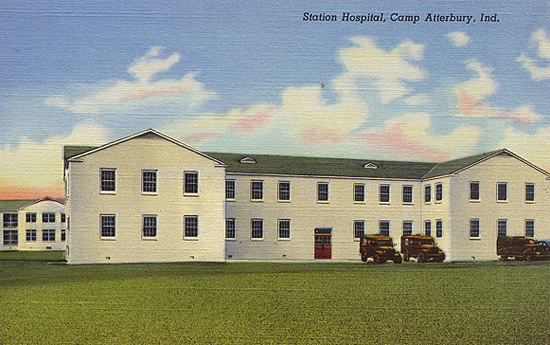
Vintage postcard showing the Station Hospital at Camp Atterbury, Indiana. Many of the Technicians from the 50th Field Hospital received technical training here during the unit’s time at the Post.
On 20 January 1944 the unit undertook its first bivouac at Camp Atterbury. Inspections were carried out to judge the completeness of training rendered to all personnel. The level of basic training was considered acceptable and the unit returned to the station to continue with practical training. This training continued until 14 February 1944, when all Technicians were relieved from duty following the unit’s alert for movement. All personnel returned to their barracks in order to prepare to leave Camp Atterbury for a destination yet unknown. All arrangements had been made for transportation and clearance, and final preparations were made for the Hospital’s departure.
Preparation for Overseas Movement:
On 16 February 1944, 22 Officers, 18 Nurses and 190 Enlisted Men left Cp. Atterbury for permanent change of station (par. 16, Special Orders # 35, Headquarters Camp Atterbury, Indiana dated 9 February 1944 –ed). Baggage and additional equipment was loaded at 0100 hours onto Pennsylvania Railroad Car # 9200. The Hospital personnel entrained at 1700 into 7 railroad cars, 4 being assigned for Enlisted personnel. NCOs in charge of the cars were as follows:
Car # 1108 – S/Sgt George L. Petrie
Car # 1399 – S/Sgt Clarence T. Pierson
Car # 1738 – S/Sgt Gilmore C. Lyon
Car # 4198 – F/Sgt Cloy D. Corley
The train left Indianapolis station at 1840 hours on 16 February 1944 for Camp Kilmer, New Jersey arriving the following day at 1253 hours. The unit detrained at 1300 hours on 17 February and prepared to move to its new location. Upon arrival, there was great confusion over the processing of the 50th for overseas duty. Very little information had been relayed to the Hospital personnel, causing severe restrictions on movement. Processing for overseas duty was completed on 21 February 1944 and passes were issued to all personnel with very little additional activity for three days.
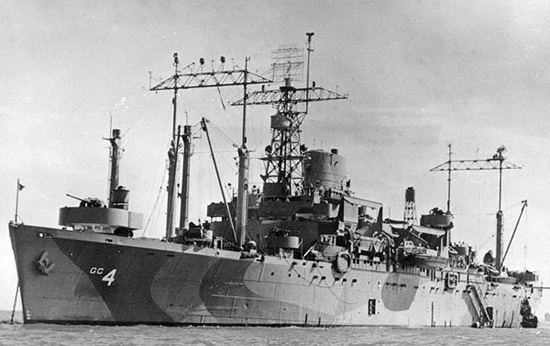
General view of USAT “Cristobal” in her wartime livery.
The unit was alerted to move to the New York Port of Embarkation on 23 February 1944 as per File SPTAA-P (EC) 370.5, and all staff once again prepared the Hospital’s equipment and their personal belongings for an imminent departure. The following day the staff entrained at 1930 hours, and departed Camp Kilmer an hour later. The train arrived approximately 2200 hours at Jersey City, New Jersey on 26 February 1944. The unit then boarded a ferry and was taken to Pier 14, Staten Island. At approximately 2300 hours the unit began to board the transport ship USAT “Cristobal”. By 2300, all personnel were aboard where they were joined by the five Officers sent ahead on the loading detail. Enlisted Men were assigned to bunks and the men finally bedded down at approximately 0100 on 27 February. The ship left the pier at 0730 hours to proceed to the unit’s new Station.
The journey across the Atlantic was largely uneventful. A number of the Hospital’s personnel suffered from seasickness and were removed from duty to the Sick Bay. “Abandon ship” drills were held daily. Very little information had been relayed to the unit as to its destination, but finally announcements were made on 6 March 1944 (at approximately 1100) confirming the rumors – the unit was heading for the United Kingdom, and was expected to land at Swansea, Wales.
Land was first sighted on 9 March when the ship arrived in the Irish Sea. Ireland and Scotland could be seen on either side of the craft. The convoy in which the unit had been traveling was thus split into two lines to proceed down the Irish Sea and the boat finally docked at Swansea at 1930 hours on 9 March 1944, after 11 days at sea.
United Kingdom:
The morning of 10 March 1944 was spent preparing for disembarkation which took place at 1420 hours. The unit’s personnel immediately entrained to proceed to Hullavington, Pinkney Park Camp, Sherston, Wiltshire. The train arrived in the small village at 1910 hours the same day, and all personnel detrained almost immediately. Once everything was unloaded from the train, trucks arrived to transport the Hospital’s personnel to the nearby Casual Camp. Since this new facility did not provide the necessary resources for Army Nurse Corps personnel, all 18 Nurses of the unit were sent to Wooten Bassett for billeting. The 50th was the first unit to arrive at the newly established camp, and so the men were assigned quickly to their tents. A light supper was served, with the Mess Hall at this time being operated by a group of Enlisted Men from the 130th Station Hospital. Having eaten, the personnel retired to their “hotels under canvas”.
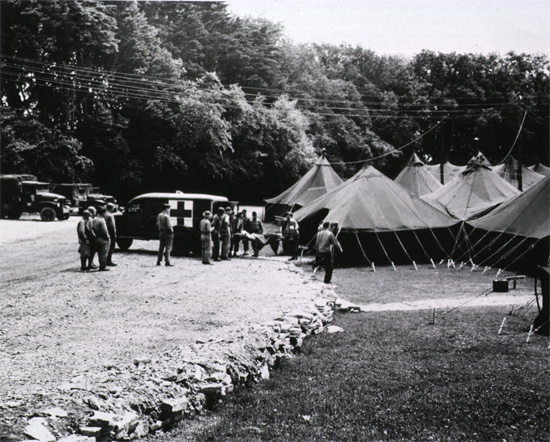
Illustration showing the admission area at the 50th Field Hospital in Weymouth, England. Photograph taken June 1944.
The following days were spent straightening out the camp area. Many of the tents required more accurate and uniform pitching, and no walkways existed in the camp yet. New units began to arrive at the camp including the 46th Field Hospital, 49th Field Hospital and the 5th, 6th and 7th Hospital Train units.
One consolidated mess was run and rations were few and far between. A mess hall was provided for use by the 50th Fld Hosp staff and a small group of men from the unit would, each evening, clean it up and prepare for breakfast the next morning. Sanitary appliances were very scarce, even brooms had to be improvised from GI scrub brushes! There were no showers or indeed running water upon arrival.
On 12 March 1944, a Provisional Medical Battalion, composed of the units currently in the camp was established, with Lt Col Blumberg being assigned as Commander.
The days that followed were spent re-orienting and organizing the camp area. This represented a significant amount of work, and both Officers and Enlisted Men were restricted to the area until all works had been completed to a satisfactory standard. Walks were constructed, and finally on 21 March 1944 the showers were completed.

Top: Overview of the sandbagged surgical area which was established at the 50th Field Hospital. Also of interest is the Mobile X-Ray Unit in the background (truck adorned with Geneva Convention markings).
Bottom: Photograph showing a Surgical Truck complete with Tent (Stock No. 24-T-321-40) at the 50th Field Hospital’s complex in Weymouth, England. Photograph taken June 1944.
On 26 March, verbal orders were received to move an advance party of 2 Officers and 30 Enlisted Men to the unit’s new location (so far unannounced) on 29 March 1944. The following day, the advance party was selected and restricted to camp in order to prepare for the move. The personnel selected for this duty were as follows:
| Maj. Marshall, Jennings B. | Tec 5 Bennetts, John T. | Pvt Bowen, John R. |
| Capt Edelson | Tec 5 Blackwood, John | Pfc Ratchford, Giles M. |
| F/Sgt Sory, Emry | Tec 5 Boose, Ralph E. | Pvt Dooley, William J. |
| Tec 3 Gavenky, Frank J. | Tec 5 Broughton, Charles M. | Pvt Hoff, Robert L. |
| Tec 4 Brown, William C., Jr. | Tec 5 Hirsch, Louis | Pvt Lance, George E. |
| Tec 4 Flower, Walter T. | Tec 5 Martin, Edward | Pvt Manthou, Diamond |
| Tec 4 Haken, Sydney W. | Tec 5 Pazdro, Walter B. | Pvt Mazzatti, Carmen J. |
| Tec 4 LeRoy | Tec 5 Stand | Pvt Murphy, James E. |
| Tec 4 Major, Richard W. | Tec 5 Czajka, Henry J. | Pvt Picard |
| Tec 4 Strangis, Joseph J. | Pfc Kosinski, Charles G. |
The above advance party of Officers and Enlisted Men departed at 0730 on 29 March for the new station of Connaught House, Weymouth, Dorset. The balance of the unit remained at Pinkney Park Camp and continued with general duties (policing, walk-building and mess duty).
At approximately 1000 hours on 4 April 1944, Lt Radman, M/Sgt Cook, S/Sgt Petrie and Sgt Magee left with three trucks loaded with supplies for the unit’s new location in Weymouth, arriving at 1300 hours. At 1300, the remainder of the 50th Field Hospital (less the 18 Nurses stationed in Wooten Bassett) departed for Connaught House via truck. The staff finally arrived at 1630 hours after an uneventful trip. Everyone was satisfied with the new location and the advance detail had carried out a great deal of work in setting up the necessary tentage for the enlisted personnel.
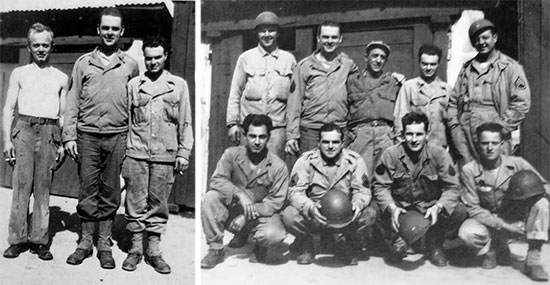
Unidentified Enlisted personnel pertaining to Detachment “C”, 50th Field Hospital, during their stay at Weymouth, Dorset, England. Courtesy Rob White.
Upon arrival, the 50th discovered that the British military still occupied part of the house and that it was being used as a hospital facility. It was operated by personnel of the British Royal Army Medical Corps and VAD (Voluntary Aid Detachment –ed). The patients were ATS (Auxiliary Territorial Service –ed) personnel. The advance detail was well established in the household when the rest of the unit arrived, but the house (even though it had been scrubbed) was still in need of a great deal more cleaning. The surrounding area was also in very bad shape. There had been substantial rainfall in the weeks preceding the arrival of the Hospital, and since no walkways existed, lots of mud and squalor surrounded the House. Initially, Hospital personnel messed with the 561st Motor Ambulance Company which was also stationed at Connaught House, but this role would eventually be taken over entirely by staff from the 50th.
Establishment of a Field Hospital at the facility was officially started early in the morning of 5 April 1944. First, the Enlisted Men’s and Officers’ tent areas were straightened out. All of the tents were struck and re-pitched in lines to form the Company. At approximately 1630 hours the same day, the Nurses returned to the Hospital from Wooten Bassett by ambulance.
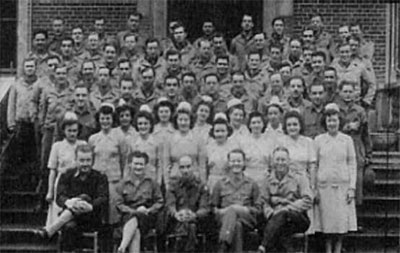
Group picture of Detachment “A”, 50th Field Hospital, somewhere in Leicestershire, England.
At 0100 hours on 9 April, Hospital staff experienced their first taste of an air raid. The alert was sounded and the men were sent to the few slit trenches that had been prepared beforehand. There was no anti-aircraft artillery and the raid lasted for only a short while. This event highlighted the inadequacies of the slit trenches and air raid shelters which had been prepared and therefore additional facilities were dug for use by the personnel.
The next few days saw the men pitching the necessary tentage for the Hospital. Hospital Ward Tents were furnished to the unit, rather than the Pyramidal Tents called for in the T/O and E. The area for the tents was marked out using ropes and it was decided that the House itself would be used for the medical wards. All of the tents were pitched over concrete slabs which had been obtained.

Barrage balloons protecting Portland area and Weymouth against enemy air raids. Row of 3/4-ton ambulances at Portland docks awaiting arrival of casualties from the D-Day fighting in France. Hards had been constructed to facilitate loading and offloading of vehicles and casualties. Additional data courtesy Rob White.
On 12 April 1944, Hospitalization Detachment “B”, 50th Field Hospital was established with 6 Officers, 6 Nurses and 57 Enlisted Men. The Section moved out to Portland, Dorset to establish an Advance Holding Company for the unit. Captain Dee W. Dailey was assigned as the Hospitalization Detachment Commander. The Section was ready to receive patients by 27 April.
At approximately 0900 hours on 28 April, the Hospital received orders to prepare for the arrival of around 140 patients. No additional details were received at this time. At 1130 hours, the first of a group of ambulances arrived bearing casualties from Portland Dockyard. These were casualties from the sinking of 2 LSTs (Landing Ship Tank –ed) on maneuvers in the United Kingdom.
“Exercise Tiger” held April 1944 in the United Kingdom for VII Corps, covered unit Invasion rehearsals including marshalling, embarkation, and assault phases. Surprise German torpedo boat attacks sank two LSTs, severely damaged a third one, and caused quite a number of casualties, including losses of some 700 American lives. The incident, although unplanned was an effective test for receiving casualties from France; the 50th Field Hospital and the 33d Medical Battalion efficiently met the emergency under trying and difficult conditions, but performed well.

Following arrival by ship from France, a patient is transferred to a 3/4-ton ambulance waiting at the Portland docks to take him to a hospital in England. Photograph taken 12 June 1944.
A constant stream of arrivals was experienced until 1700 hours. Most of the men had been in the water for some time, and were sent to the British Red Cross in Weymouth for billeting. Of the 140 patients that were admitted to the Hospital, 53 were pronounced dead on arrival, with the remaining patients being treated for their injuries. Two (2) patients were sent to Portway Hospital, Weymouth where they received oxygen therapy. Since ward space was limited, the patients were evacuated as quickly as possible to the 228th Station Hospital located nearby. The influx of patients continued well into the night and by the end of the day on 29 April, a total of 253 DOA casualties had been received, and processed through a representative of the Quartermaster Graves Registration Service. By 30 April 1944, all patients had been evacuated to the 228th Station Hospital for further treatment and convalescence.
At 1500 hours on 30 April, Brigadier General Charles O. Thrasher (Commanding General, Southern Base Section) visited the complex for an unexpected tour. The visit lasted only 30 minutes, but was worthwhile. Thrasher indicated that the unit could expect a further tour of inspection from Major General John C. H. Lee (Deputy Theater Commander) on 2 May 1944. He also made a few suggestions for changes in procedure in readiness for the subsequent visit. Major General Lee arrived at the facility at approximately 1500 hours and was pleased with the operation.
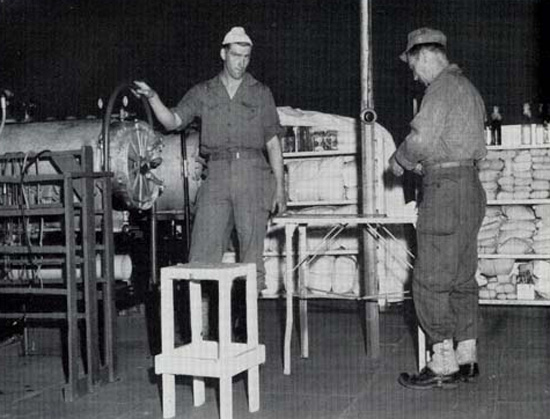
Supplies of sterile items are maintained at the 50th Field Hospital in readiness for the invasion of Normandy, and the arrival of the unit’s first patients.
On 12 May 1944, 2d Lt Evelyn B Chabot, ANC (N-751271) and 2d Lt Isabel M Rinaldi, ANC (N-721263) joined the unit from the 67th General Hospital to replace 2d Lt Mildred D Carr, ANC (N-729518) and 2d Lt Dorothy L Willis, ANC (N-729278) who were reassigned to the 67th Gen Hosp.
At approximately 1940 hours on 29 May 1944, Major General Paul R. Hawley (Chief Surgeon, ETOUSA –ed) arrived at the facility for an inspection tour of the Hospital. He was met by Col Blumberg and taken around the area. He enjoyed dinner with the unit’s Officers, and stayed long into the small hours of the following morning.
At approximately 0800 hours on the morning of 6 June 1944, M/Sgt Cook turned on the radio and the men heard for the first time, the news that the Invasion of Europe had begun. Planes had been passing over the facility for the majority of the night, and 2 patients were received from a crash. One of the Lieutenants was pronounced dead on arrival. There was no further activity on D-Day itself, but the staff had been told to prepare for casualties in the days to follow.
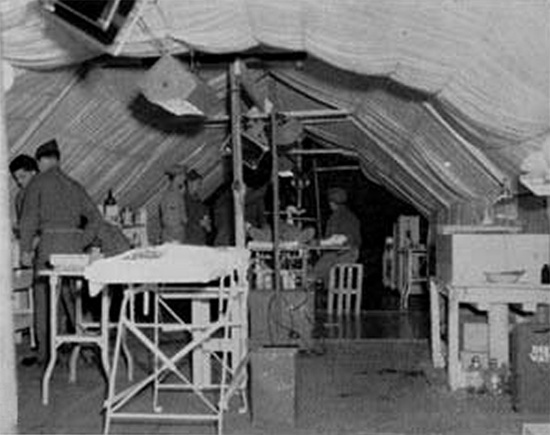
Fully-equipped Operating Room at the 50th Field Hospital.
At approximately 0700 the following day, the casualties began to arrive. The patients were all US servicemen, and treated as quickly as possible. They were not at the 50th Fld Hosp long; most were quickly evacuated to surrounding Hospitals so that ration distribution and valuable ward space could be preserved. The number of casualties received was considerably less than had been forecast. The first German patients (PWs) were admitted on 10 June, with another 5 being received the following day (it should be noted that the 12th Field Hospital and the 50th Field Hospital operating as Holding Units at Portland-Weymouth, together with the 46th Field Hospital located at Southampton, received most of the non-transportable casualties from the D-Day fighting).
Casualties continue to be received from the units in Normandy throughout June and into July, but towards the end of this period admissions were very low. Many of the patients admitted had already received treatment from medical units and hospitals established in Normandy, and typically had their wounds re-dressed and convalesced. The largest influx of patients was received on 14 July 1944, when a total of 107 patients were brought in via LSTs. A handful required immediate attention and care, while the majority had been treated already. A further 104 patients were received on 17 July under the same circumstances.
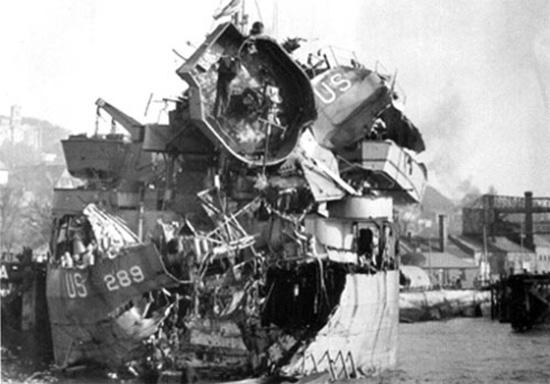
LST 289 showed serious battle scars after its run-in with German patrol boats during Exercise Tiger off the British coast in April 1944. Injured troops were treated at the 50th Field Hospital.
The stream of patients slowed throughout July and by 30 July 1944, most had been evacuated to other facilities either in the United Kingdom or ZI. By 16 August 1944, the patient count was so low that the personnel began packing equipment for movement. No orders had yet been received, but they were expected. At approximately 1700 hours on the same day, Col Blumberg received a telephone call ordering the unit to have one Platoon ready to move immediately to a new station. The Platoon was composed of 6 Officers, 6 Nurses and 55 Enlisted Men. At 2200 hours the personnel moved out to Aldermaston Air Field, Newbury. The balance of the staff continued to pack the equipment in readiness for the orders to move out.
Detachment “A” was the first to receive verbal orders to move out on 23 August 1944. The Detachment was to be sent on Temporary Duty to the 110th Station Hospital located in Southampton, and arrangements were made to move the entire Section the following day at 1000 hours. The assignment lasted only a matter of days and on 29 August all personnel within Detachment “A” were returned to the 50th Fld Hospital. The section was thus re-designated as Detachment “B”, while Detachment “B” would be re-designated as Detachment “A” and attached to the 82d Airborne Division in Leicester, Leicestershire. The unit proceeded at approximately 2200 hours to its new destination.
Detachment “B” received new orders the following day that it was to be attached to the 101st Airborne Division at Newbury, Berkshire. The unit departed the facility at approximately 0700 hours the same day.
Only Detachment “C” remained at Connaught House, and awaited further orders to go to the continent. After much waiting around and confusion, orders were finally received on 7 September 1944 that the Hospital was due in the Dorchester Marshalling Area on 10 September.
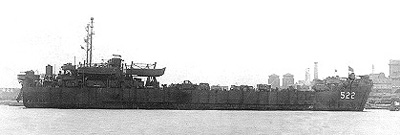
Overall view of LST # 522 which would transport the equipment and personnel of the 50th Field Hospital to the coast of Normandy.
The morning of 11 September 1944 was spent in getting the Marshalling Area straightened up for departure, as the unit was to board a single LST the same day. Everything was prepared by noon, and the staff were issued life belts in readiness for the trip across the Channel. The American Red Cross served coffee and doughnuts. The troops arrived at the pier at 1550 hours and by 1555 hours had begun boarding LST # 522. The night was spent aboard the craft in Portland Harbor and the ship left England the following morning for France at approximately 0730 hours.
United Kingdom Stations – 50th Field Hospital
50th Field Hospital > Connaught House, Weymouth, England
Detachment “A” – Southampton, England
Detachment “B” – Portland, England
Detachment “C” – Connaught House, Weymouth, England
Assignments – 50th Field Hospital
Detachment “A” – 101st Airborne Division, Newbury, England
Detachment “B” – 82d Airborne Division, Leicester, England
Headquarters + Detachment “C” – Connaught House, Weymouth, England
France:
The crossing was relatively smooth and the Hospital (less Detachment “A” and Detachment “B”) landed at Utah Beach on 12 September 1944 at approximately 2115 hours. The unit remained aboard the LST all morning and at 1300 hours began disembarkation. After moving off the beachhead and into Staging Area “B”, the unit personnel moved to a location approximately 3 miles from Sainte-Marie-du-Mont, arriving at 1600 hours. The men immediately began to pitch shelter tents for their stay in the area.
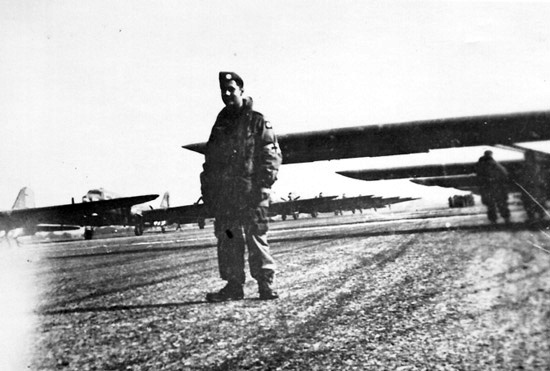
A member of the 50th Field Hospital attached to the 82d Airborne Division prepares to board a glider for Holland. Photograph taken in September 1944.
On 26 September, notification was received that the 50th would move out the following day to Liège, Belgium. Capt Irwin, along with 6 Enlisted Men left the bivouac area that night for the new station. The remaining Officers, Nurses and Enlisted Men would leave via Hospital Train No. 21 on 28 September 1944. Entraining took place at 1600 hours on 27 September 1944 at Chef-du-Pont, departing at 1710 hours via Carentan and Saint-Lô.
France Stations – 50th Field Hospital
Headquarters + Detachment “C” – Sainte-Marie-du-Mont, France
Holland:
The XVIII Airborne Corps of which the 82d and 101st Airborne Divisions were an intrinsic part based their medical plans on lessons learned during D-Day. Equipment was revamped and supply allowances of Regimental and Battalion Medical Detachments reviewed, adapted, and increased. This included more use of gliderborne ¼ ton-trucks (aka jeeps) and trailers. In the end, besides reinforcing the organic Airborne Medical Companies with an Auxiliary Surgical Team, a Field Hospital Platoon coming from the 50th Field was attached to the units as from August 1944. Prior to 17 September some changes took place whereby Detachment “A” was now assigned to the 82d Airborne and Detachment “B” went to the 101st Airborne Division. Some time was spent for glider training as the extra medical personnel was to go in by glider with the rest of the Companies they were to assist.
Assignments – 50th Field Hospital
Detachment “A” – 82d Airborne Division, Holland
Detachment “B” – 101st Airborne Division, Holland
Belgium:
Hospital Train No. 21 arrived in Liège at approximately 1245 hours on 2 October 1944. Upon arrival, Lt Enger met the personnel and informed them that transportation was waiting outside to take the Hospital staff and equipment to the new station. The 50th was to stay at the 28th General Hospital in an old Belgian fort in the city (Fort de la Chartreuse –ed). The personnel boarded trucks and ambulances and headed for their new destination. No one yet knew how long the stay here would be…
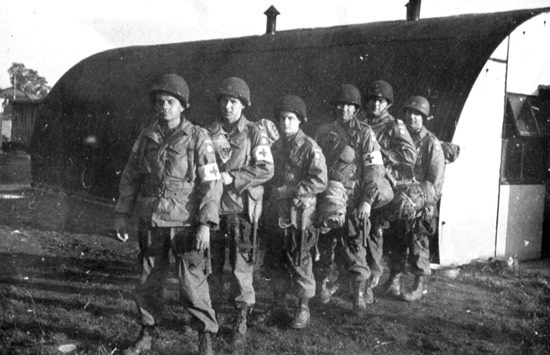
From left to right: 2d Lt William M. Wilson, Capt George I. Mishtowt, Capt John R. Hall, Maj Jennings B. Marshall and Capt Dee W. Dailey preparing for their trip to Holland.
Upon arrival at the Fort on 4 October, the Hospital’s personnel began to prepare their quarters and the necessary sections of the command. The setup of the Operating Room took almost two days, but was ready to receive patients in an emergency. Other areas of the Hospital still required additional work to complete them as satisfactory. On 14 October, Col Blumberg went to Namur to look over a potential site for the 50th Fld Hosp. He identified a military hospital which had been previously operated by German medical staff, which could prove ideal. The building was already home to 400 Officers of the Advance Section, Communications Zone, and it was decided that the unit was to establish a 150-bed Station Hospital for them. A subsequent visit to Namur four days later highlighted another location, this time a Château on the outskirts of the city. The decision was made that this would now be the new home for the 50th. Instructions were received on 21 October that the unit was to prepare for movement to Dave, Belgium. An advance party, headed by Col Blumberg and Sgt Corley left the following day to prepare the site.
The next day, more personnel and equipment were moved to the location, leaving the Nurses and a handful of Enlisted Men and Officers at the 28th General Hospital. The transfer of personnel and equipment to Dave was finally completed on 27 October 1944 with the arrival of the Surgical Section. A great amount of work was required to establish a functioning hospital on this new site, and orders had been received that the unit should be ready to receive patients by 1 November. By 30 October, everything had been prepared with the exception of the Surgery. To expedite the process, 13 civilians from the neighborhood were employed by the unit as well as 10 German PWs. The first patients were received on 2 November 1944; 1 Officer, 8 Enlisted Men, 3 British soldiers and 1 German PW. A number of additional patients (largely US troops) were received over the next few days.
The station-type hospital continued operation throughout November, during which time the other two Detachments (“A” and “B”) had been relocated to France, still assigned to duty with the 82d and 101st Airborne Divisions respectively. On 19 November, 6 Nurses left the unit in Dave to work with the 82d Airborne Division in the Divisional Station Hospital and were thus transferred to Detachment “A”, 50th Field Hospital. On 27 November, following a V2 Rocket attack on their own station, 12 Nurses from the 15th General Hospital in Liège were assigned to duty with the 50th Fld Hosp, and would remain with the unit into the new year.
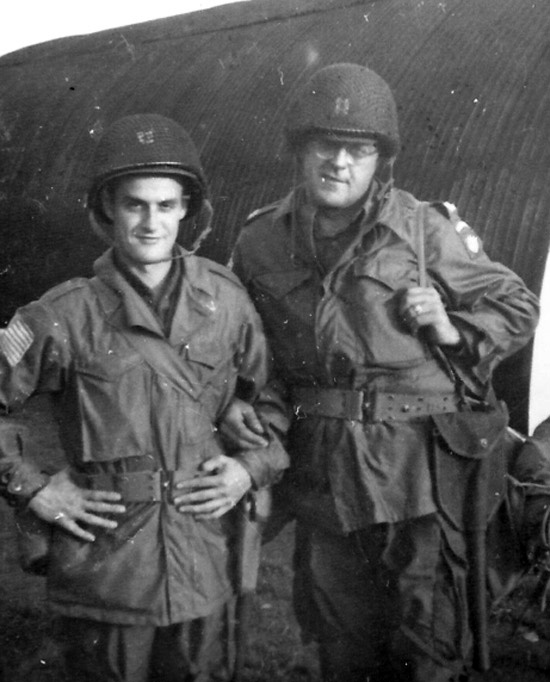
Captains John R. Hall and Dee W. Dailey are pictured wearing M-1943 Combat Uniforms in readiness to join the 82d Airborne Division during Operation Market-Garden. September 1944.
The end of 1944 saw Detachment “C” of the 50th Field Hospital continuing its operation of a Station Hospital at Dave (Château de Dave, along the River Meuse), Belgium. Detachment “A” was located at Camp Sissonne, France with the 82d Airborne Division, while Detachment “B” was stationed at Camp Mourmelon-le-Grand with the 101st Airborne Division. The patient census for Detachment “C” at this time was 2 Officers, 30 Enlisted Men and 55 Prisoners of War. Both Detachments “A” and “B” of the unit were officially inactivated as separate organizations on 10 February 1945. All personnel and equipment that had supported the Airborne Divisions was returned and absorbed by Headquarters and the Medical Detachment, 50th Field Hospital, and continued to operate as a single hospital unit
Upon the return of the equipment, numerous thorough checks were carried out for shortages, and any excess property was returned to the nearby Medical Depot. The arrival of the personnel required a separate building to be secured, in which all of the new staff were billeted. The stay didn’t last long, however. On 4 March 1945, Detachment “A” was once again activated as a separate Detachment, and departed for Liège the same day. It was to operate with the 93d Medical Gas Treatment Battalion in air evacuation. The Detachment did not leave with a complete assembly of supplies, as only certain types of surgical work were anticipated. The remaining Medical Detachment continued to operate the Station Hospital at Dave.
On 17 March 1945, orders were received for Headquarters and Detachment “A” to move from Namur to Grâce-Hollogne, Belgium. The new mission for the 50th was to operate as a 400-bed Holding Unit for air evacuation assisted by the 6th Medical Sanitary Company (Italian). All supplies were to move via truck, and Detachment “A” was to meet the remainder of the unit at the new station. The move was accomplished by approximately 1900 hours. The building used by the unit was an old factory which lent itself well to the functions of the Hospital.
Three large wards were opened, including a large store room and enlisted billets. Officers and Nurses were stationed in nearby homes. Ward 1 was used for British and ComZ litter patients; Ward 2 for all ambulatory patients and Ward 3 for Zone of Interior patients. A total of 400 beds were available. For the most part, the unit’s personnel had not experienced this kind of medical operation before, and lots of changes to procedure needed to occur. Typically, patients would remain at the facility for only a few hours, before being evacuated further.
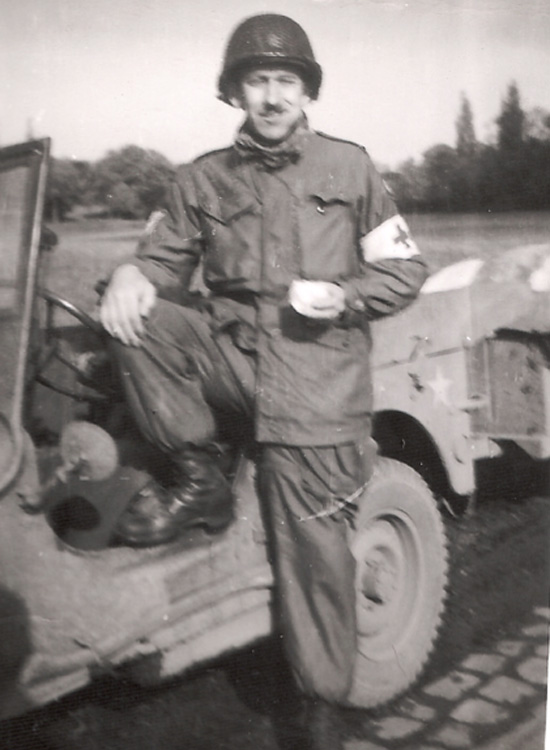
Maj Jennings B. Marshall pictured in Holland, 1944.
On 24 March 1945, the 14th Field Hospital arrived at the airstrip and started preparing a medical facility in the location. It was envisaged that the Hospital would be ready to receive patients by 1 April, and that it would thus take over the duties of the 50th Fld Hosp. The next few days saw the 50th winding down its operations. Any supplies which could be spared were packed away in readiness for the next assignment, while major departments (namely X-Ray and Surgery) continued operation. The 50th Field Hospital was officially closed at 2400 hours on 31 March 1945.
The next few days saw the unit packing away equipment and preparing to move off to the new location. On 7 April 1945 the remaining Detachment “C” at Grâce-Hollogne ceased operation, and all patients were evacuated. The unit now waited until further orders were received. On 9 April 1945, orders came in instructing that one Hospital Detachment was to be sent to Paderborn, Germany. Detachment “C” was selected for this duty, and the equipment and personnel began to assemble. Trucks arrived on 11 April to move the Detachment at 0930 hours. Everything was packed into the transport and the personnel finally departed at 0100 hours the following morning. The remaining staff and personnel was still awaiting orders at this time.
On 13 April 1945, Maj John L Sharp, accompanied by 5 Officers and 40 Enlisted Men left as an advance party for an unknown destination in Germany. The only supplies that accompanied the party were a complete mess assembly and emergency rations. Everything was prepared and the men departed at approximately 1330 hours. The balance of the unit was still unaware of the new location, but it was guaranteed to be Germany, that much was for sure.
Belgium / France Stations – 50th Field Hospital
50th Field Hospital > Fort de la Chartreuse, Liège, Belgium
Detachment “A” – Sissonne, France
Detachment “B” – Mourmelon, France
Detachment “C” – Château de Dave, Dave, Belgium
Belgium / France Stations – 50th Field Hospital
50th Field Hospital > Château de Dave, Dave, Belgium
Detachment “A” – Werbomont, Belgium
Detachment “B” – Mourmelon, France
Detachment “C” – Château de Dave, Dave, Belgium
Germany:
Orders were finally received on 19 April 1945 that the unit would move the following day to Bad Godesberg, Germany. On 20 April, trucks arrived at 0830 hours to transport the Hospital staff and personnel. Departure had been expected immediately after the noon meal, but was delayed as one of the trucks had a flat tire. The unit finally departed Belgium at 1600 hours, arriving at Von Carstegen Estate, Bad Godesberg at approximately 2300 hours. As of this time, the unit’s assignment was unknown. Two hundred (200) beds were set up for billeting of the personnel, and additional tents were pitched for the Surgery, X-Ray and Supply Sections.
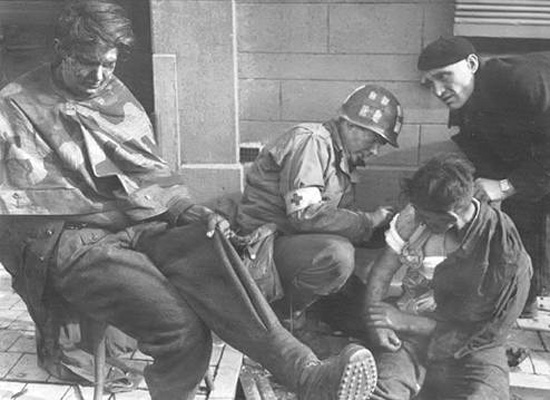
Precious medical care is given to a wounded Prisoner of War by an American Medic, assisted by a local Belgian.
On 22 April 1945 Detachment “A” was once more officially activated under the command of Maj. Jennings B. Marshall. The mission of the newly re-formed Detachment was to operate a 1,000-bed Prisoner of War Hospital at PWTE A-3 (Prisoner of War Transient Enclosure –ed). For this operation, the Detachment was assigned to the 106th Infantry Division at Bad Kreuznach, Germany. The personnel and equipment departed the same day at approximately 1000 hours. In view of the harsh conditions prevailing in the transient facilities, medical assistance and intervention was the only way to prevent mass death and disease among the German Prisoners. ADSEC’s Preventive Medicine Division sent special teams to dust all PWs including any American personnel that had been in contact with them. Elements of various Field Hospitals supported the existing PW Enclosures and new PW Hospital Centers had to be established with German medical personnel working under the general supervision of American Medical Officers. Operational control of all PWTEs would become the mission of several divisions at first, but ultimately of the 106th Infantry Division alone.
Prisoner of War Transient Enclosures, Germany, spring 1945
PWTE A-1 > Rheinburg
PWTE A-2 > Remagen
PWTE A-3 > Bad Kreuznach
PWTE A-4 > Büderich
PWTE A-5 > Sinzig
PWTE A-6 > Winzenheim
PWTE A-7 > Biebelsheim
PWTE A-8 > Dietersheim
PWTE A-9 > Wickrathburg
PWTE A-10 > Koblenz
PWTE A-11 > Andernach
PWTE A-12 > Heidesheim
PWTE A-13 > Urmitz
PWTE A-14 > Plaidt
PWTE A-15 > Planig
PWTE A-16 > Zahlbach
PWTE A-17 > Hechtsheim
Little information was received as to the unit’s operative capacity at this new location. The next few days saw the men continuing with the establishment of the necessary equipment, and the unit operated as a Staging Area for special teams traveling through to assignments in Germany. All of the personnel were billeted in the tents pitched by the 50th Fld Hosp, while the command personnel were quartered in nearby homes.
On 29 April orders were received to the effect that within the next few days the unit would once again be on the move. The location was not confirmed, but expected to be in the vicinity of Bad Kreuznach.
Transportation was expected to arrive on 31 April 1945, but turned up at the Hospital at 0930 hours on the morning of 30 April. Four trucks were loaded and departed at 1400 hours. Headquarters left at 1500 hours, followed by the remaining 3 trucks at 1600 hours. Upon arrival at PWTE A-6, a tent was pitched temporarily some distance from the final Hospital location for messing. The same evening, 2 trucks were unloaded at the proposed new site, but some difficulties were experienced due to the heavy rainfall and snow. All supplies were unloaded and immediately tarped as quickly as possible. Two empty trucks then returned to Bad Godesberg to bring the remainder of the supplies and the rear Detachment. The move was accomplished later that night, and the new location was finally learned – Winzenheim, Germany.
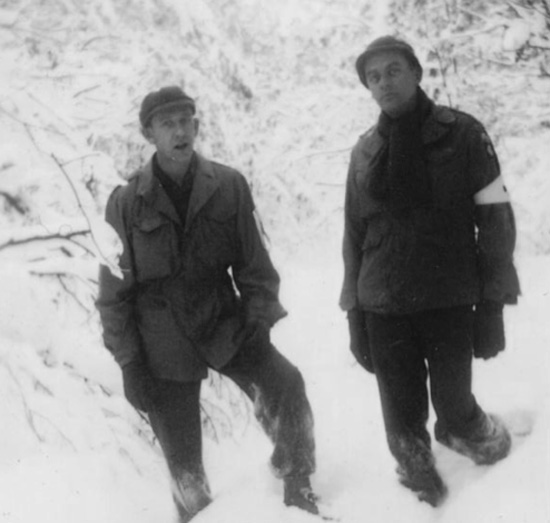
Two unidentified members of the 50th Field Hospital pictured in thick snow during the Battle of the Bulge.
The Hospital received its first patients the following day (1 May 1945), and the total census was 715. Out of approximately 70 clinically typhoid cases, 25 were proven positive by laboratory studies. The unit continued to operate in this capacity for the rest of the month, and total admissions to the facility were 1,528, with 814 returned to duty, 418 evacuated, 174 dead, leaving a total of 837 patients remaining at the facility at the end of May. Additional tents, litters and blankets were needed to handle the influx of patients, and expansion of the facility began.
The evacuation of patients was accomplished with the assistance of the 560th Motor Ambulance Company, with the majority of patients discharged being evacuated to the German General Hospital at Idstein. Meanwhile the unit’s Medical Detachment, assisted by the different Detachments continued training German medical personnel in order to gradually take over operations at the PWTEs under supervision of American Medical Officers.
All American equipment in use around the Hospital was replaced by German items as rapidly as they became available. Expendable supplies in use by this time were almost 100% German, with the exception of small items that were not yet available. A German x-ray machine was also secured for use by the unit and was thus prepared for use.
On 28 May, Detachment “A” which had been attached to the 93d Med Gas Treat Bn since April 1945 moved from Helmstedt to Bad Kreuznach to join the main unit. Temporary quarters were secured for the additional personnel in the town. Messing was also carried out at the Hospital facility.
Two days later, Detachment “A” was once again moved to Hechtsheim, Germany where it was to establish a Prisoner of War Hospital at PWTE A-17.
Orders were received on 31 May 1945 for Headquarters Detachment, 50th Fld Hosp to once again relocate to Bretzenheim, Germany. The mission was to establish yet another PW Hospital, this time at PWTE A-6. Trucks arrived the following day to transport the personnel and equipment necessary for the new assignment, and by 4 June 1945 the Detachment was operating independently of the other Detachments. Several new procedures were instigated as a result. A courier service between the numerous Detachments was established, and many of the administrative duties of the Detachments were handled by the Headquarters, and distributed via this service.
On 7 July 1945, Detachment “B” received orders to evacuate all patients and cease operation. Additional ambulances were once again secured from the 560th Motor Ambulance Company to complete the evacuation process. The orders received on this date also indicated that any US Army equipment still in use by the numerous Detachments was to be withdrawn from service in readiness for turning the facilities over to French occupation troops. Any excess American equipment was thus turned in to the Medical Depot at Bingen, Germany (M-409 –ed).
The next few days saw the other Detachments closing their Hospitals and returning to the old location at Bad Kreuznach where the two Detachments (A and B) were to continue operations until further orders were received.
On 11 July, information was received that indicated movement orders had been dispatched, sending the 50th Fld Hosp to Dijon, France within the next few days. It was expected that the unit would operate a Station Hospital at this location, but no confirmation had been received.
The following day, official instructions were received to move all Hospital personnel, TAT (To Accompany Troops –ed) equipment and Hospital equipment of all Detachments from Bad Kreuznach to Camp Sissonne, France. Maj Sharp was assigned the Train Commander, with Capt Mishtwot being given the position of Train Surgeon.
A total of 9 boxcars were provided by the Transportation Corps (3 per Detachment), with an additional box car used for messing, and 10 “40 et 8” (Quarante Hommes et Huit Chevaux, 40 men and 8 horses –ed) cars for the personnel. The train departed at 1500 hours on 14 July 1945, with the remaining equipment making the journey in 6 2 ½-Ton Trucks.
Germany Stations – 50th Field Hospital
Detachment “A” – Bad Kreuznach
Detachment “B” – Bad Godesberg
Detachment “C” – Paderborn
France:
All personnel and equipment traveling by rail arrived at the new location Caserne Gouraud, France (former site of the 200th General Hospital –ed) at approximately 1100 hours on 16 July 1945. Personnel were billeted on the post and immediately began to unload and assemble the unit’s equipment. Upon the arrival of the remaining Detachments on 18 July 1945, all three (A, B and C) were de-activated and absorbed back into the 50th Field Hospital. The Hospital’s opening date as a 250-bed Station Hospital in this location was set at 25 July 1945.
The site required a great deal of cleaning and preparation before the facility could receive patients. To expedite the process, Prisoners of War were employed, along with civilian workers from the surrounding area. A total of 250 beds were available for the opening date, as well as a functioning 24-hour dispensary service and dental clinic. The opening date of 25 July arrived and notification was received that the Hospital was not to open as originally intended.
The days that followed saw the personnel undergoing additional training courses, and further preparing the Hospital. A number of the personnel were transferred to units headed for another Theater of Operations, namely those with a low number of points.
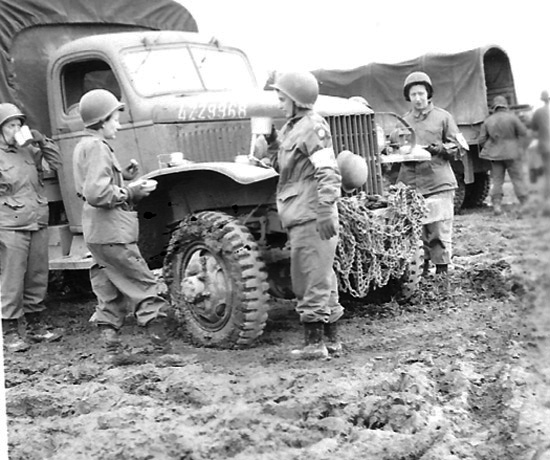
Trucks and Nurses of the 50th Field Hospital experience dreadful conditions in Belgium during the Battle of the Bulge. Photograph taken January 1945.
The unit finally opened in this location at 0800 hours on the morning of 6 August 1945 providing a 250-bed Station Hospital as originally speculated. The patient count was relatively low, and thus personnel continued to undergo additional redeployment training programs and recreational activities. Furloughs, passes, and trips to Belgium, the French Riviera, and the United Kingdom were appreciated by all. A farm project was also initiated by the personnel, which could furnish the Hospital and its neighboring units with a good supply of fresh vegetables.
On 1 September 1945, Col Leon D Blumberg was relieved of command of the 50th Field Hospital and transferred to the 2d General Hospital for immediate return to the United States and release from active duty. Major Jennings B. Marshall (O-400409) assumed command of the unit. On 6 September 1945, 1st Lieutenant Mildred H. Zullo, ANC (N-758873) was transferred to Château-Thierry, France, for service with the 50th Field, where she was first put in charge of the Detachment of Patients, and later appointed Chief Nurse of the Hospital, becoming responsible for the remaining 18 Nurses.
The following day, Capt Dailey accompanied by 3 Nurses and 46 Enlisted Men traveled to Château-Thierry, France as Detachment “A” (not officially activated) to operate a Station Hospital at the former location of the 49th Field Hospital (Camp San Francisco –ed). Organic equipment applicable to a Field Hospital Detachment accompanied the troops during this move.
The period of September to November was spent continuing with operations at Camp Sissonne, France. Detachment “A” operated its Station Hospital until 14 October 1945. The 50th Field Hospital was awarded the Meritorious Service Unit Plaque for performance of duty and exceptionally difficult tasks, and for the achievement and maintenance of a high standard of discipline, during the period 10 March 1944 – 11 June 1945.
On 23 September 1945, Maj Marshall was relieved of his command of the 50th Fld Hosp, and assigned to Separation Center # 48 for discharge from the service. Capt George I. Mishtwot (O-463245) assumed temporary command the same day, and was replaced by Maj Francis W. Anderson (O-25153) on 17 October 1945.
On 25 October 1945, Detachment “A”, 50th Field Hospital was officially activated as a separate unit. It departed for St. Florentin, France on 26 October 1945 to operate a Station Hospital for troops of the 101st Airborne Division. Supplies and equipment applicable to a Hospital unit accompanied the troops to their new assignment. One of the Detachments provided medical support to a PW Hospital at Villers-Hélon, France, while the other Detachments continued to operate at Soissons and St. Florentin, France.
The Hospitalization Unit continued to operate a 250-bed Station Hospital until December. During this period, a number of the ‘high pointers’ from the other Detachments were redeployed. The last week of November 1945 saw approximately 120 men from the unit with point scores of 60 to 68 being transferred out. On 1 December Detachment “B” moved to the Reims area to set up a local Station Hospital for American troops staging in the area. Detachment “A” was de-activated on 8 December 1945, with all personnel, records and equipment being re-assigned to the 50th Field Hospital proper. A library, consisting of 500 soft-bound books, as well as numerous magazines and other literature was added to the unit. The library proved to be a great factor in keeping the morale of the personnel at a high level, and an additional reading and writing room were also added. Around 17 December 1945 the 188th Motor Ambulance Detachment was temporarily assigned to the 50th.
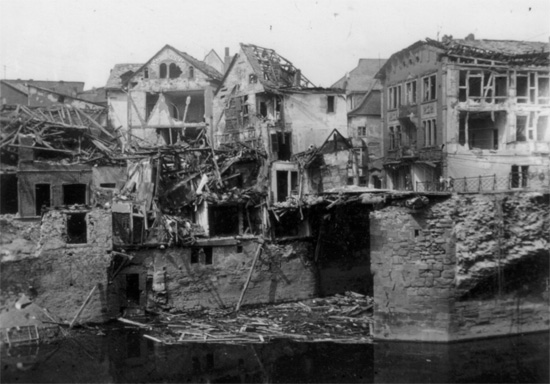
Photograph showing extensive battle damage to numerous buildings in Bad Kreuznach, Germany.
The command continued to lose Officers and Enlisted Men throughout December. By the end of the month, all Enlisted Men with point scores of between 56 to 59 left the unit, as well as Officers that met the Redeployment requirements.
Operations of both Detachment “B” and the main 50th Field Hospital continued well into 1946. On 20 February 1946, the former organization was inactivated and re-joined Headquarters and the Medical Detachment at Camp Sissonne, France.
26 February 1946 saw 103 Enlisted Men transferred to the 165th General Hospital for redeployment to the ZI, leaving a total of 161 personnel assigned to the unit, with 97 being present for duty. Notification was officially received on 7 March 1946 that the unit would cease to function on 13 March and move to Paris on 20 March to the site of the 239th General Hospital. Further transfers were made out the unit in the days that followed, and the evacuation process of the current patient census begun. Patients were sent to either the 239th General Hospital, or the 78th Field Hospital.
Movement orders were finally received on 18 March and the unit moved out of its location at 0830 on 20 March 1946 to Villejuif, France. The movement was completed the same day, and all personnel of the 50th Fld Hosp were placed on Temporary Duty to the 239th Gen Hosp.
Transfers continued to take their toll on the unit’s roster throughout the month of April, and by the end of the month only 2 Officers and 16 Enlisted Men were present for duty. The unit thus prepared for a consolidation with the 239th. It was during this period that the men of Detachment “A” received the Belgian Fourragère 1940 (ref. Royal Decree No. 2086, dated 3 April 1946 –ed) for their action with the 82d Airborne Division during the Battle of the Bulge (December 1944).
Only 1 Officer and 16 Enlisted Men remained at the unit for the final closing of the Hospital. All documents were prepared and full inventory reports submitted. Elements of the 50th Field Hospital would remain in France until 1947, during which time the unit was returned to the Zone of Interior.
Roster:
Officers:
| Blumberg, Leon D. (Lt Col) O-368015 | Curtis, Richard I. (Capt) O-418450 | Hynes, John E. (Capt) O-489031 |
| Marshall, Jennings B. (Maj) O-400409 | Dailey, Dee W. (Capt) O-422086 | Minix, William, G. (Capt) O-1533636 |
| Sharp, John L. (Maj) O-315432 | Duimstra, Fred (Capt) O-419550 | Mishtowt, George I. (Capt) O-463245 |
| Aprile, Joseph I. (Capt) O-389240 | Dunn, Emmett R. (Capt) O-315474 | Enger, James A. (1st Lt) O-1543503 |
| Biddle, Robert M. (Capt) O-418689 | Edelson, Zanly C. (Capt) O-366861 | Fitzgerald, Lawrence P. (1st Lt) O-536685 |
| Bloom, William (Capt) O-516190 | Fishman, Melvin B. (Capt) O-417127 | Morris, George E. (2d Lt) O-516870 |
| Brown, James C. (Capt) O-1684818 | Gardner, Paul E. (Capt) O-407425 | Radman, Robert H. (2d Lt) O-1545914 |
| Budd, Byron B. (Capt) O-1688126 | Gosman, Solomon D. (Capt) O-362212 | Wilson, William M. (2d Lt) O-422980 |
| Carey, Gregory M. (Capt) O-408310 | Hall, John R. (Capt) O-422980 |
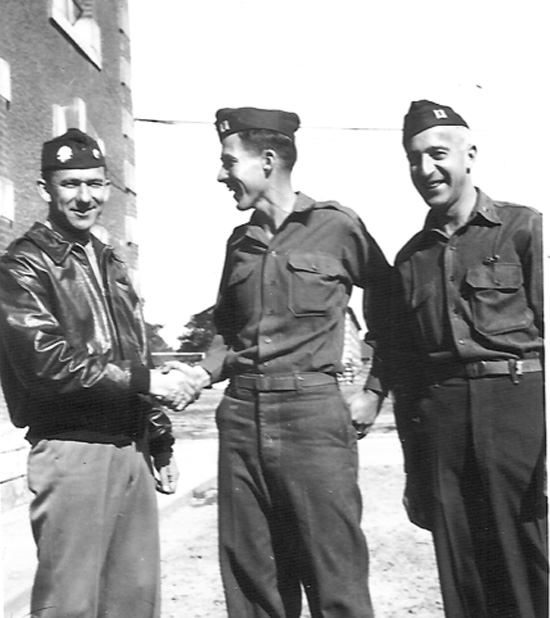
Photograph showing Maj Jennings B. Marshall, Capt George I. Mishtowt and Capt Paul E. Gardner.
Nurses:
| Beavans, Helen E. (1st Lt) N-729905 | Dishon, Helen M. (2d Lt) N-729276 | Rinaldi, Isabel M. (2d Lt) N-721263 |
| Edwards, Margaret M. (1st Lt) N-732989 | Fishley, Mary J. (2d Lt) N-72523 | Sheessele, Eleanora M. (2d Lt) N-729804 |
| Jordan, Martha J. (1st Lt) N-767467 | Kuttig, Ednah N. (2d Lt) N-729190 | Smith, Amy L. (2d Lt) N-728664 |
| Linkel, Mary E. (1st Lt) N-728922 | Lang, Mildred D. (2d Lt) N-729246 | Vegh, Margaret A. (2d Lt) |
| Lockhart, Cleona O. (1st Lt) N-729248 | Lynn, Mary O. (2d Lt) N-729249 | Watson, Ruby (2d Lt) N-704139 |
| Meyer, Mary E. (1st Lt) N-728937 | Mastroianni, Ellen | Willis, Dorothy L. (2d Lt) N-729278 |
| Carr, Mildred D. (2d Lt) N-729518 | Miller, Amelia R. (2d Lt) N-729113 | Zullo, Mildred H. (1st Lt) N-758873 |
| Chabot, Evelyn B. (2d Lt) N-751271 | Potter, Arbutus (2d Lt) N-767073 |
Enlisted Men:
| Aimar, Albert A. | Goldfarb, Alan | Myers, Leo E. |
| Allen, Willie G. | Gosman, Solomon D. | Oehlers, Elmer K. |
| Alter, George M. | Goth, Bernice | Olinski, Edward F. |
| Babbitt, Frank J. | Gottsleben, Fererick H. | Osborne, Frank W. |
| Ballinger, Silas M. | Gouveia, Cecero | Parigian, George |
| Banks, Lewis A. | Groff, Warren F. | Patrick, Keith G. |
| Bennetts, John T. | Gronseth, Gordon O. | Pazdro, Walter B. |
| Benning, Raymond | Grossman, Frank J. | Perry, Albert L., Jr. |
| Bentivenga, Emil C. | Grusin, Clemance J. | Pesce, Diamente |
| Berghoefer, Hans | Haken, Sydney W. | Peterson, William J. |
| Birnberg, Hans | Hamilton, John A., Jr. | Petrie, George L. |
| Birnberg, Irving | Hanson, Roy S. | Pierce, Raymond M. |
| Birsner, Frank A. | Harkrider, Clifford A. | Pierson, Clarence T. |
| Blackwood, John | Heard, Joel E., Jr. | Pietrewicz, Leonard S. |
| Blanch, James R., Jr. | Heon, Joseph E. | Pinnix, John F. |
| Bouchard, Albert R. | Herling, Leonard F. | Pitchford, John T. |
| Bolton, Albert R. | Hess, Freddie N. | Pleus, Leon H. |
| Bolton, Leland S. | Hieb, Harry L. | Plummer, Kemp |
| Bonner, Simon R., Jr. | Hirsch, Louis | Pruiett, William R. |
| Boose, Ralph E. | Hirsch, Nathan | Purdy, David G. |
| Borosky, Joseph E. | Hiscox, Charles A. | Quaranto, Joseph A. |
| Bowen, John R. | Hoff, Robert L. | Quinn, John C. |
| Bowen, Thomas W. | Honaker, McKinley | Raphael, William H. |
| Boyle, George V. | Hood, Johm | Rapp, Hartley M. |
| Bray, Roy L. | Hott, William P. | Ratchford, Giles M. |
| Broughton, Charles M. | Houle, Paul M. | Redding, William E. |
| Brown, William C., Jr. | Hughes, John J. | Reppke, Ralph J. |
| Burke, Ray C. | Hutchinson, Daniel M. | Resch, John G. |
| Canavan, William P. | Hynes, John E. | Rockwell, Louis J. |
| Carney, Francis P. | Iadanza, John | Rodmann, Robert H. |
| Carnrike, Harry M. | Ill, Joseph M. | Roering, Raymond C. |
| Christensen, Francis E. | Ingram, Stephen M. | Rohde, Henry |
| Christopher, Francis A. | Irvin, Edward W. | Rohme, James |
| Cohen, Bernard L. | Jacobs, George F. | Roman, Martin J., Jr. |
| Collette, Joe C. | Jankowski, Casimir B. | Rosenstock, Kurt S. |
| Collins, Elza P. | Janssen, Albert C. | Rosenthal, Hans |
| Colokathis, Paul P. | Janutolo, Thomas M. | Rudy, Frederick C. |
| Conroy, John R. | Jasko, Louis J. | Russell, William D., Jr. |
| Conyer, Arthur D. | Jaswinski, William | St. John, James A. |
| Cook, John R. | Johnson, Howard A. | Sawyer, William C. |
| Cordell, Lester E. | Johnson, John W. | Schiffris, George |
| Corley, Cloy D. | Johnston, Forrest | Schneider, Roy D. |
| Cornwell, Rufus G. | Jones, Olon | Schroeder, Leonard W. |
| Costa, John L. | Kallens, Frank Jr. | Schwartz, Simon |
| Crandall, Herbert D. | Keeney, Ollie L. | Scott, Arthur T. |
| Czajka, Henry J. | Kipness, John | Scutari, Albert M. |
| Daly, James F. | Klenzman, Laverne I. | Sellhorn, Charles J. |
| Davies, James B. | Klinger, Robert T. | Sharp, John L. |
| Davis, Pat G. | Klotz, Michael B. | Sheehan, Paul W., Sr. |
| De Ciechi, Charles H. | Koating, Carroll E. | Smith, Earl |
| Derencz, Michael L. | Kohn, Paul | Smith, Edward W. |
| Derrick, James A. | Kosinski, Charles G. | Smith, Henry K., Jr. |
| Dlugokecki, Zigmunt J. | Kraft, Victor D. | Smith, Roy |
| Dooley, William J. | Lance, George E. | Snow, Earl W. |
| Eastman, Everett J. | Lanzel, Marvin G. | Soltis, Edward A. |
| Eno, William F. | Larocca, Daniel J. | Sory, Emry |
| Erickson, Kenneth L. | La Rosa, Joseph | Stefanucci, Vincent F. |
| Erlichman, Joseph | Lewis, Arthur | Stepien, Joseph J. |
| Evanoff, Steve | Lewis, Clyde E. | Strangis, Joseph J. |
| Evans, DeWitt C. | Lewis, John G. | Stuart, Leonard G. |
| Felton, Murmel D. | Long, Victor T. | Szatkowski, Stephen E. |
| Fernandi, Italo A. | Lubitow, Irving M. | Taylor, Carl I. |
| Fernes, Warren M. | Lucas, Ernest L. | Thiellen, Edward G. |
| Filomena, Gennaro A. | Lyon, Gilmore C. | Thompson, John A. |
| Fine, Samuel P. | McDonald, Robert J. | Trent, Charlie C. |
| Fischer, Stanley | McGonigal, Dennis M. | Tuciarone, Frances |
| Fisher, Sydney | Magee, James O. | Tucker, Clarence A. |
| Fitzgerald, Laurence P. | Major, Richard W. | Tutko, John J. |
| Flower, Walter T. | Manning, Thomas J. | Vaccaro, Libero P. |
| Folkner, Ben W. | Manthou, Diamond | Venesky, Edward W. |
| Foster, Paul A. | Martin, Edward | Vivier, John |
| Frenkel, David | Martin, Hugh M. | Wax, Archie E. |
| Fried, Joseph | May, Boris E. | Weidhorn, Albert |
| Furmari, Casper | Mazzatti, Carmen J. | Wheeler, Archie E. |
| Gaden, Louis | Mehrer, Olin E. | Wheeler, Wayne H. |
| Garafalo, Emilio J. | Michalicka, Joseph I. | Williams, Edward Jr. |
| Gavenky, Frank J. | Miraldi, Frank | Wilson, William M. |
| Gilbert, Bud A. | Murphy, James E. | Woodward, William I. |
| Gilbert, Howard R. | Murphy, Marvin D. | Wright, John T., Jr. |
| Gilbert, Raymond D. | Murray, David D. | Young, Birge S. |
| Gliottone, Emilio P. | Muzio, Carl |

Portrait of an unidentified Staff Sergeant of Detachment “C”, 50th Field Hospital, while stationed in Weymouth, Dorset, England. This person could well be Harry A. Dougan, ASN 36437497, from Madison County, Illinois. Courtesy Rob White.
The authors would like to sincerely thank British researcher and re-enactor, Loz Wright who kindly provided them with numerous original documents which have allowed the editing of this Unit History. The MRC staff are still looking for additional information relating to the unit’s return to the ZI and official deactivation. If any readers are able to assist, they would be most grateful indeed. Additional thanks are due to Rob White, son of Lance Corporal Sheila Mitchell, ATS, who served as a telephone operator with Headquarters, 189th British Heavy Antiaircraft Regiment, at Blackdown House, Buxton Road, Weymouth (situated opposite the 50th Field Hospital, established at Connaught House, Weymouth), the photos were taken in the period April-September 1944.
